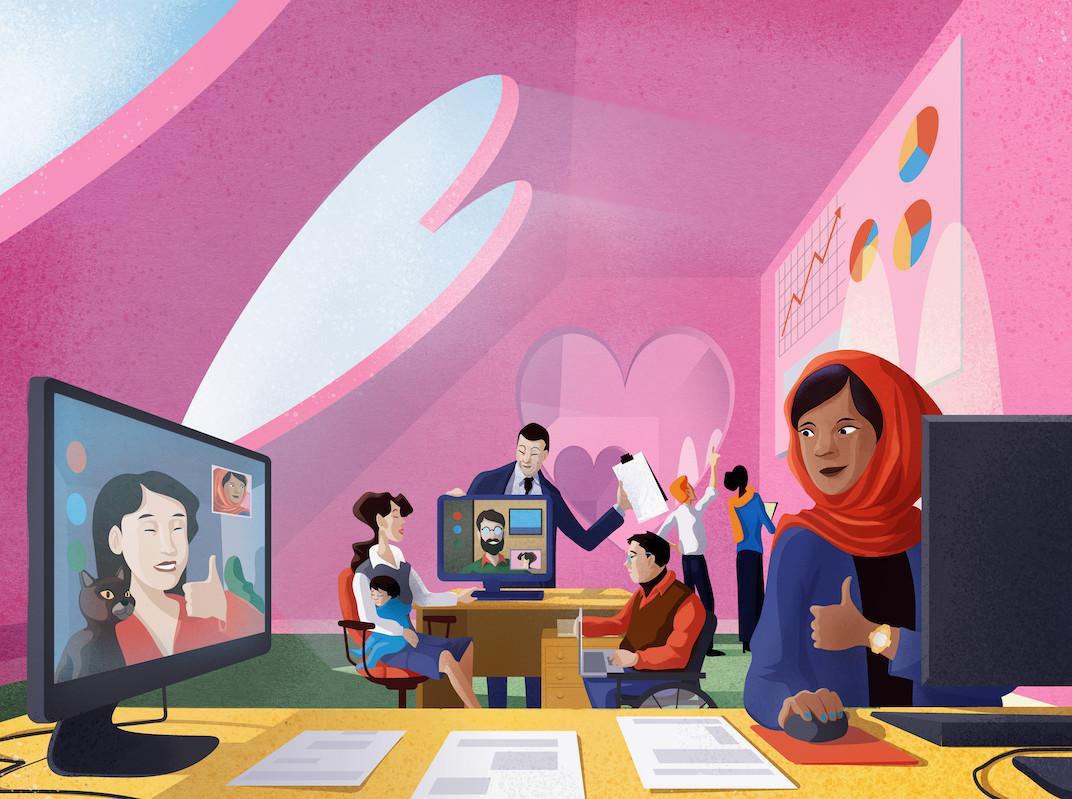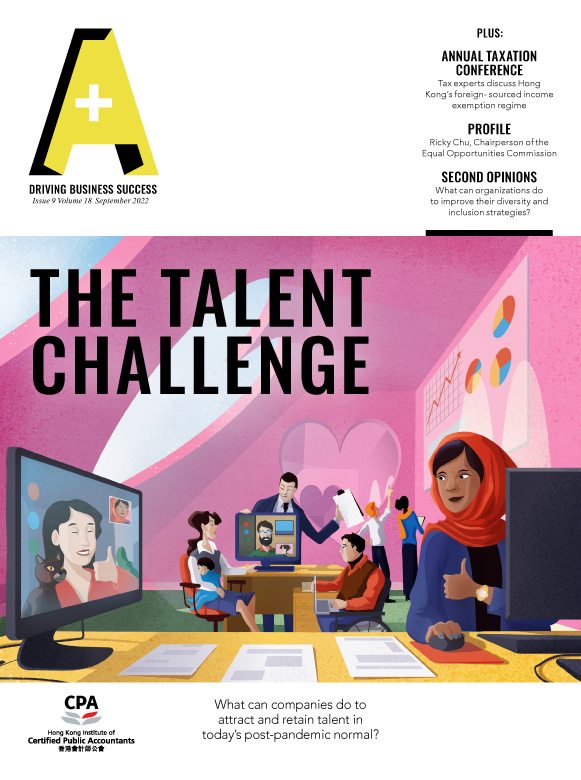The office, as we remember it, was ready to go back to normal. With the availability of COVID-19 vaccines since early 2021, and billions of jabs administered to people worldwide over the next 18 months, all was in place for a safe return to pre-pandemic work routines.
But that hasn’t been the case. Employers and employees around the world have since been locked in a delicate game of tug-of-war – on one end, are bosses who are hoping to return to “the way things were” prior to the COVID-19 pandemic and calling staff back to work at the office full time. On the other end, are employees – many of whom are decidedly content with “the way things are” now.
This unique situation has led to employees worldwide leaving their jobs en masse since 2021, known as “The Great Resignation.” The United States, for example, saw almost 48 million employees leave their jobs in 2021 alone, according to the U.S. Bureau of Labour Statistics, while in India, over a million in the IT sector resigned that same year. While Hong Kong has largely been spared from workers resigning in droves, many are actively considering it, according to PwC’s Global Workforce Hopes and Fears 2022 Hong Kong (SAR) Report. The August study, which surveyed 1,043 workers in Hong Kong, found that 49 percent of employees say they are likely to leave their jobs, while 23 percent note that they are extremely likely to change jobs within the next 12 months – higher than the global average of 34 and 19 percent, respectively.
This new employment paradigm has put employers in a difficult situation which will magnify in complexity over the next decade. By 2030, millennials, or those aged between 25 to 34, will make up more than 40 percent of the global working age population, while generation Z, or individuals aged between 18 to 24, will comprise 26 percent of all labour, according to Demographic Shifts: The World in 2030, a study by Cushman & Wakefield. This larger pool of younger workers will make it crucial for managers to act now to understand their needs in order to gain their talents and long-term loyalty.
Joyce Fok CPA, Senior Recruiting Manager at Robert Half Hong Kong, says that the pandemic has essentially prompted employees across the world to re-examine what they want out of a job, leading many to leave if those requirements cannot be met. Flexible working arrangements, she adds, is now a prerequisite for most employees. “Candidates are willing to accept a lower salary – provided it isn’t lower than their current package – with the promise of more flexibility. Some are also turning down jobs simply because they don’t offer remote work,” she says.
The PwC report found that 89 percent of employees prefer to work mostly or entirely remotely. It also found that only 45 percent of workers, however, have the option of working remotely. A separate study by Randstad, conducted between February and March, found that 35 percent of millennials would quit their jobs if they aren’t able to choose where they work. The issue is more apparent for generation Z with 41 percent noting they would leave their jobs if they couldn’t work remotely.
But increased flexibility is merely one of the requirements that employees now have when looking for a job, and that will convince them to stay. Today’s talent, according to Louisa Yeung FCPA, Chief Executive Officer of recruitment agency KOS International, seek companies that cultivate a diverse and inclusive workplace culture, offer opportunities for professional development, and are led by individuals who understand the importance of honest and transparent communication, and employee mental well-being. “Before the pandemic, the focus was on the usual – being next in line for a promotion, having a better title and making more money. Of course this is still important, but now, employees want a lot more,” she says.

“Before the pandemic, the focus was on the usual – being next in line for a promotion, having a better title and making more money. Of course this is still important, but now, employees want a lot more.”
Why remote work is working
The pandemic essentially upended people’s work routines, leading to a lifestyle shift, Yeung says. The lack of a commute freed up time for other tasks, and the increased reliance on video calls and communication tools meant that employees didn’t necessarily have to be at the office, or even in the same country, to collaborate in real-time. “Before COVID, much of the global working population had to physically show up at the office five days a week. But now, people have the choice to show up at the office only when necessary, like to attend in-person meetings,” she says.
Though this meant attending to calls outside working hours, work-from-home arrangements continue to challenge traditional office work settings and hours, since they generally provide employees with more flexibility to manage their own professional and personal lives, and also enhances the general well-being of staff, says Becky So CPA, Director, Human Resources of a European investment bank. “Employees now prefer to avoid jobs with rigid work schedules. For example, some might prefer to start work a bit later but compensate by working longer in the evening and vice versa,” So says. “People also appreciate the flexibility to occasionally run some errands during the day.”
This independence is especially crucial for those who have family members to take care of, notes Vincent Tam FCPA, Head of Talent Management at Hong Kong Productivity Council. “Employees like being able to choose when to start or end their day. This allows working parents to spend more time with their kids,” he says.
But for flexible working arrangements to truly work, trust has to be established between both parties; employers should measure an employee’s performance based on the quality of work they produce, while employees need to be accountable for their own tasks, says Derek Yuen CPA (practising), People Partner, Audit, KPMG China. “We remind staff that we look at results and their collective team effort. We believe that accountability and delivering quality work is more important than their physical presence in the office,” he says. Not all duties, however, can be done remotely, Yuen cautions. “It isn’t easy for an auditor to work remotely all the time, as they often have to work within teams and need access to office space and equipment.”
Despite the advantages of working remotely, it isn’t for everyone, So says. “For some, their homes may have limited space to work; they may lack the right desk set-up or a separate room to attend calls, and there may be disturbances at home like children crying or pets. It depends on whether people can concentrate in their homes as well,” she says. “It also makes it difficult to bond with new joiners, and there can be a lack of overall team spirit in the long run.” The option to work remotely equally depends on the industry the individual works in, Yeung says. “If one works in the food and beverage industry or in essential services, there’s no way they can work from home.”
Employees are also more susceptible to cyberattacks or phishing emails if they work remotely or from home, notes Tam. “Not all employees are provided with a laptop from the company. This exposes them to all sorts of risks, especially if their laptops don’t have any protective software,” he says. “It can be risky if employees are accessing work-related systems and potentially sensitive or confidential data. Companies have to find ways to address this early to prevent potential breaches.”
In spite of the potential drawbacks, Yeung is convinced that remote work is set to continue, making it crucial for companies to consider offering it to attract and retain talent. “As more traditional chief executive officers in their 60s and 70s start retiring within the next decade, many of whom still prefer the office, the younger CEOs of today are more likely to allow staff to work from home, as they are more open to remote models,” she says. “With a lot of young employees asking for remote work, more ‘old school’ CEOs are feeling the need to follow this trend. They don’t have much choice now.”

“With a lot of young employees asking for remote work, more ‘old school’ CEOs are feeling the need to follow this trend. They don’t have much choice now.”
Building a diverse and inclusive workplace
Beyond offering increased flexibility, employers need to cultivate a diverse and inclusive culture within the company. Doing so fosters a sense of belonging among employees, which Tam explains, can lead to a multitude of other benefits. “When employees feel included and respected, they are more willing to go the extra mile, and will likely produce work of a higher quality. This will lead to better results and more satisfied customers,” he says, emphasizing that staff feel most valued by their company when they are heard and treated fairly. “When employees feel that their ideas aren’t being taken seriously, this could prompt them to consider leaving. It is crucial for employers to empower their employees and recognize their individual skills and talents.”
While diversity and inclusion (D&I) may not be as important as remuneration for jobseekers, it is key to retaining staff, especially younger workers, according to Deloitte’s Global 2022 Gen Z & Millennial Survey, which found that a company’s efforts to create a diverse and inclusive environment would encourage gen Z and millennial employees to stay on for more than five years.
In order to grow a diverse and inclusive culture within the workplace, the D&I tone has to come from the top, explains Tam. “D&I initiatives have to align with organizational goals and the company’s values,” he says, adding that employers could start by taking a second look at their recruitment process. “Management first need to get rid of their own biases. They should make a concerted effort to look beyond the candidate’s gender, ethnicity and nationality and focus purely on their qualifications, academic achievements and whether they are competent enough for the role.”
So agrees, highlighting that companies should set D&I-related metrics and targets to guide employers throughout the hiring process. “Companies are recommended to set key performance indicators (KPIs) to establish a target ratio of women in the leadership team and a target mix of overseas and local talent.” she says.
Offering the option to work remotely also counts as a D&I initiative nowadays, Tam points out. “This greatly benefits employees who may have physical disabilities, allowing them to work directly from home,” he says. “They don’t have to worry about travelling back and forth to the office every day.”
For the top-down approach to D&I to truly work, companies need to ensure that their middle management is also composed of a mix of individuals, says Yeung. “Nowadays, it shouldn’t be weird to see people of diverse backgrounds making up a company’s middle or even upper management team,” she says. “Companies have to first set this example before they even start talking about D&I; they have to walk the talk.” A diverse middle management team, Yeung adds, will also ensure that D&I-related goals and initiatives cascade down from management and are successfully put into play. “Employees are proud to work for a company that doesn’t discriminate and are equal employers. They want to see companies objectively assess the skills and capabilities of different people and allow them to be promoted. This will help to attract and retain individuals from all walks of life.”
“Employees are proud to work for a company that doesn’t discriminate and are equal employers.”
A conducive work environment
Employers should aim to encourage collaboration, open communication, and provide regular and timely feedback, which may warrant a change in management styles, So says. “Some managers may still adopt a slightly more dictator-like approach; they would expect staff to strictly follow orders – but millennials may not appreciate this kind of style,” she says. “Nowadays, managers are advised to carefully explain to staff why they need to do certain tasks and perhaps the consequences of their actions or inactions. A collaborative management style with an element of coaching would be a more welcomed approach nowadays.”
Fok agrees, adding that employees prefer managers who provide more autonomy and have a noticeably less intrusive style of management. “Though many employees still appreciate receiving training the first few months, employers should practice a more hands-off approach afterwards to allow candidates to learn on the job. As a result, employees will feel a greater sense of trust from their employers,” she says.
Yuen says younger employees also value receiving more frequent and honest feedback from managers. “Employees care about their performance, and it’s our goal to build a high performance culture at the firm. This means we need to be as transparent as possible in terms of what they can do better,” he says. Yuen adds it is therefore crucial for employees to be aware of the KPIs they need to fulfill in order to meet the company’s expectations.
In addition to providing feedback, Tam says that employers should create a workplace culture of recognition and appreciation of employees, regardless of whether they are commending large or small accomplishments. “Taking the time to appreciate or praise employees for their efforts can go a long way. Celebrating achievements will build upon that sense of belonging and also motivate them to perform better.” Employees also appreciate a workplace environment that values mental health. However, as many as 35 percent of millennials workers and 33 percent of gen Z staff feel uneasy about speaking with their managers about their stress, anxiety or any mental challenges they may be experiencing, according to the Deloitte report. “It starts with promoting a culture of ‘openness’ within the company. People shouldn’t feel discouraged to share their feelings, especially if they aren’t feeling their best,” Yeung says.
It isn’t only about retaining younger staff members, Tam emphasizes, noting that companies should provide ongoing training to all employees. “With so many new forms of technology available today, companies should provide training to help middle aged employees reskill or upskill. This will boost their confidence,” he says. “It will also help them to cope with added job roles or projects and manage them in a more efficient or proficient manner.”
Regular communication with staff members may also help employers to unearth both their short- and long-term career goals, and help managers to understand what functions at the company they would be keen to try out, says Fok. “If an employee has already been working in the company for two or three years, they may have grown slightly bored of their current responsibilities and may benefit from rotating at different desks,” she says. “This will allow them to learn different things while being at the same company.” Yuen agrees: “It is up to the company to offer them different tasks. This could be through secondment opportunities, or taking on different functions through internal rotation programmes. This should be part of every company’s retention strategy.”
“Celebrating achievements will build upon that sense of belonging and also motivate them to perform better.”
Being worthy of talent
Employers are encouraged to identify which areas to enhance within the company to lure and hold onto the best talent in today’s competitive hiring environment. “The market is now more candidate-driven, so at this moment, employers have less bargaining power,” Fok points out.
Employers therefore have to take initiative to proactively and mindfully promote themselves and the organization, Yuen concludes. “The dynamics of hiring have changed. Two decades ago, it was very one sided – we’d pick the employees – but it’s two-way traffic now,” he says. “It’s now our responsibility to explain why the company is a good fit to each candidate. After all, it is people that make a business, so having the best talent is most important.”
In Hong Kong, 49 percent of employees say they are likely to leave their jobs, while 23 percent note that they are extremely likely to change jobs within the next 12 months, according to PwC’s Global Workforce Hopes and Fears 2022 Hong Kong (SAR) Report.
















